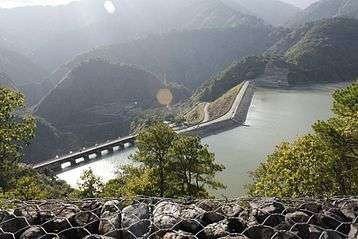Ambuklao Dam
| Ambuklao Dam and Hydroelectric Plant | |
|---|---|
 | |
.svg.png) Location within the Philippines | |
| Official name | Ambuklao Dam |
| Country | Philippines |
| Location | Bokod, Benguet |
| Coordinates | 16°27′38″N 120°44′42″E / 16.460419°N 120.744885°ECoordinates: 16°27′38″N 120°44′42″E / 16.460419°N 120.744885°E |
| Construction began | July 1950 |
| Opening date | Dec. 23, 1956 |
| Construction cost | Php 132,000,000 (66,000,000 USD) |
| Owner(s) | National Power Corporation |
| Dam and spillways | |
| Type of dam | Central Core Rock-fill Embankment |
| Impounds | Agno River |
| Height | 129 m |
| Length | 452 m |
| Width (base) | 8.50 m |
| Spillways | 8 |
| Reservoir | |
| Creates | Ambuklao reservoir |
| Total capacity | 327,170,000 m3 with no sedimentation |
| Active capacity | 258,000,000 m3 with no sedimentation |
| Catchment area | 690 km2 |
| Surface area | 7.5 km2 |
| Power station | |
| Turbines | 3 units, Francis Horizontal Shaft |
| Installed capacity | 75 MW, 105 MW after rehabilitation (2011) |
| Annual generation | 332 GWh |
Ambuklao Dam is part of a hydroelectric facility in Brgy. Ambuklao, Bokod, Benguet province in the Philippines. The development of the Agno River for purposes of hydroelectric power generation, flood control, and irrigation had been conceived as early as the late 1940s. Preliminary investigations for development at Ambuklao and Binga Dam sites were undertaken as early as January 1948. With maximum water storage capacity of 327,170,000 cubic metres (265,240 acre·ft), the facility, which is located 36 km (22 mi) from Baguio city, can produce up to 105 megawatts of electricity to Luzon grid. The main source of water comes from the Agno River which originates from Mt. Data.[1]
The dam and other non-power components are owned by the government through the National Power Corporation (NAPOCOR).[2]
Ambuklao Hydro
The Ambuklao Hydroelectric Power Plant is one of the oldest power plants in the country and was among the first large hydroelectric power plants constructed in the Philippines. Running along the upper portion of the Agno River, Ambuklao Hydro was constructed for power generation and flood control.
In July 1990, a massive earthquake hit Luzon, resulting in siltation and technical problems that affected the plant’s operations. Ambuklao was eventually decommissioned in 1999.
SN Aboitiz Power-Benguet, Inc. (SNAP-Benguet) won on November 28, 2007 the public bid for Ambuklao and its neighboring power facility Binga, which were sold as a package under the power sector privatization program of the Philippine government. SNAP-Benguet is a joint venture between SN Power of Norway, and AboitizPower.[3]
SNAP-Benguet began a massive rehabilitation project that restored Ambuklao to operating status and increased its capacity from 75 MW to 105 MW. The project required the construction of a new intake, headrace and penstock, elevation of tailrace tunnel outlet, de-silting of tailrace tunnel and replacement of electro-mechanical components. In June 2011, Unit 3 became the first turbine unit to go on-line, followed by the other two units. Ambuklao was formally inaugurated in October 2011.[4]
Ambuklao is designed as a peaking plant and is capable of delivering energy and providing ancillary services needed to stabilize the grid.
References
- ↑ http://www.cityofpines.com/ambuklao.html
- ↑ "Ambuklao Dam". www.napocor.gov.ph. Retrieved 2016-01-14.
- ↑ http://www.philstar.com/business/740905/aboitiz-group-opens-ambuklao-dam
- ↑ "Ambuklao". www.snaboitiz.com. Retrieved 2016-01-14.